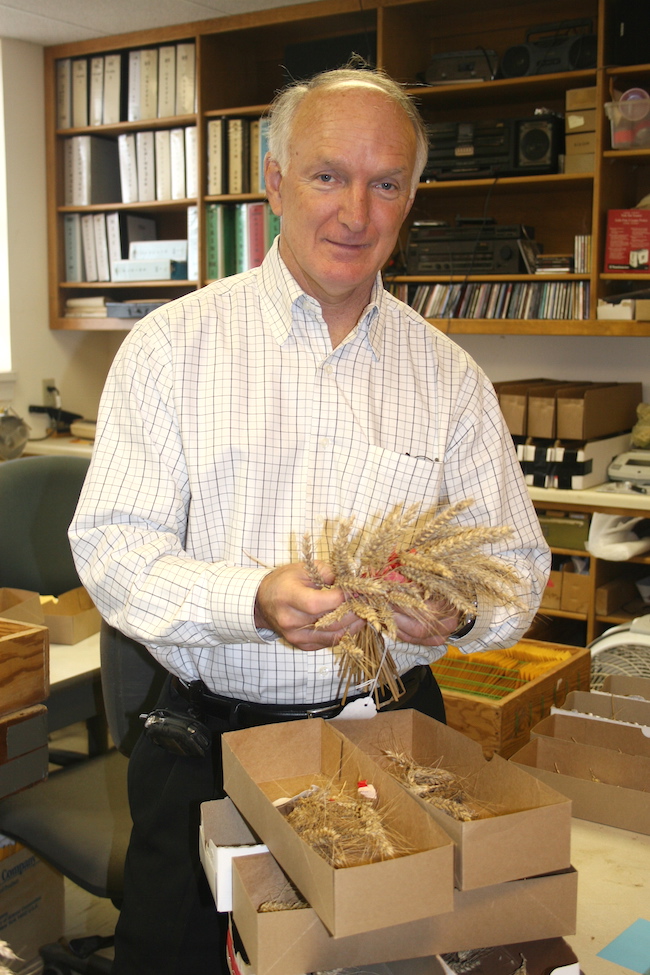As a young man working on his family’s farm in Perry, Georgia, Jerry Johnson loved the sight of wheat growing in the fields. Decades later, Johnson, now a respected plant breeder and crop and soil sciences professor, received the 2015 Inventor’s Award from the University of Georgia Research Foundation (UGARF) for his work breeding wheat varieties for farmers in Georgia and across the Southeast.
“I grew a lot of wheat and soybeans with my father and my uncle. I always thought the wheat was pretty growing in the fields during the wintertime, when everything else is brown and there are no leaves on the trees,” he said.
Johnson attended Abraham Baldwin Agricultural College and UGA, completing his undergraduate degree in agronomy. While at UGA, he worked with Morris Bitzer in Bitzer’s wheat breeding program before accepting an assistantship at Purdue University. There, he earned master’s and doctoral degrees in plant breeding and genetics. He served as an assistant professor at the University of Maryland before returning home to Georgia in 1977 to teach and conduct research at UGA’s campus in Griffin, Georgia.
Thirty-eight years later, Johnson has produced close to 50 wheat varieties. Throughout his career, he made at least 1,000 wheat crosses annually, which led to an average of two new wheat varieties each year. “I’ve been fortunate that, in some years, we released three or four (new varieties) and, in some years, none,” he said.
To breed a new variety, Johnson takes two plants and crosses them together to get what’s called an “initial cross.” He watches those crosses grow generation after generation for about six years before selecting the best crosses. Three more years of field testing gives Johnson time to view, evaluate and record the new variety’s performance.
“From that point, it takes another year to release the new variety. From cross to release, it’s 10 years, so you really have to enjoy delayed gratification to be a wheat breeder,” Johnson said.
All of the wheat varieties released through Johnson’s research program in the UGA College of Agricultural and Environmental Sciences were bred to increase farmers’ yields while decreasing insect and disease pressure.
“The primary goal is that we breed for yield — because that’s how farmers get paid — and excellent test weight. To maintain the yield, we have to build in Hessian fly (a major wheat pest) and soil-borne disease resistance. Other diseases, like leaf rust, can be controlled with fungicides if necessary, but there’s a cost involved there,” he said.
Johnson is most proud of AGS2000, a wheat variety he says put the UGA Wheat Breeding Team “on the map.” UGARF licensed AGS2000 to Georgia-based AgSouth Genetics and the variety “helped them become successful,” Johnson said.
“It is high yielding, has a good disease package and excellent test weight, and is broadly adaptable from Georgia all the way up to Arkansas and into North Carolina,” he said.
In addition to being grown by American farmers, wheat varieties from Johnson’s research have been used by other scientists to breed new varieties for Brazil, Hungary and Argentina.
The total gross license revenue received by UGARF from the commercialization of Johnson’s varieties totals nearly $3 million.
“When it comes to plant breeding, you have to have a passion for what you want to do. It’s a lot of hard work, and you have to really love it and enjoy it. I really enjoyed my time here at UGA, and the Griffin Campus has been a great place to work. I have a lot of friends here, and I’ll miss them more than the plant breeding,” said Johnson, who recently retired but plans to help transition the UGA wheat breeding program into the hands of newly named program breeder, Mohamed Mergoum.








